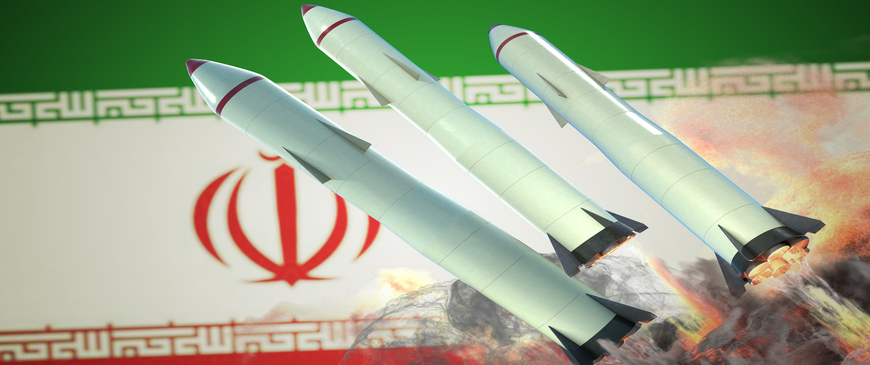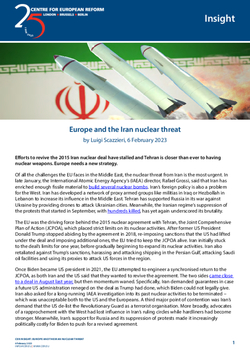
Europe and the Iran nuclear threat
Efforts to revive the 2015 Iran nuclear deal have stalled and Tehran is closer than ever to having nuclear weapons. Europe needs a new strategy.
Of all the challenges the EU faces in the Middle East, the nuclear threat from Iran is the most urgent. In late January, the International Atomic Energy Agency’s (IAEA) director, Rafael Grossi, said that Iran has enriched enough fissile material to build several nuclear bombs. Iran’s foreign policy is also a problem for the West. Iran has developed a network of proxy armed groups like militias in Iraq or Hezbollah in Lebanon to increase its influence in the Middle East. Tehran has supported Russia in its war against Ukraine by providing drones to attack Ukrainian cities. Meanwhile, the Iranian regime’s suppression of the protests that started in September, with hundreds killed, has yet again underscored its brutality.
The EU was the driving force behind the 2015 nuclear agreement with Tehran, the Joint Comprehensive Plan of Action (JCPOA), which placed strict limits on its nuclear activities. After former US President Donald Trump stopped abiding by the agreement in 2018, re-imposing sanctions that the US had lifted under the deal and imposing additional ones, the EU tried to keep the JCPOA alive. Iran initially stuck to the deal’s limits for one year, before gradually beginning to expand its nuclear activities. Iran also retaliated against Trump’s sanctions, harrassing and attacking shipping in the Persian Gulf, attacking Saudi oil facilities and using its proxies to attack US forces in the region.
Once Biden became US president in 2021, the EU attempted to engineer a synchronised return to the JCPOA, as both Iran and the US said that they wanted to revive the agreement. The two sides came close to a deal in August last year, but then momentum waned. Specifically, Iran demanded guarantees in case a future US administration reneged on the deal as Trump had done, which Biden could not legally give. Iran also asked for a long-running IAEA investigation into its past nuclear activities to be terminated – which was unacceptable both to the US and the Europeans. A third major point of contention was Iran’s demand that the US de-list the Revolutionary Guard as a terrorist organisation. More broadly, advocates of a rapprochement with the West had lost influence in Iran’s ruling circles while hardliners had become stronger. Meanwhile, Iran’s support for Russia and its suppression of protests made it increasingly politically costly for Biden to push for a revived agreement.
While efforts to resuscitate the deal have faltered, Iran’s programme has kept expanding and Tehran is closer to having a nuclear weapon than it has ever been. Iran is currently enriching uranium to 60 per cent purity, and it would not take long for it to enrich to 90 per cent, the level needed to make weapons, if it decided to do so. The West may not get much warning if Iran makes that decision, because since early 2021 Iran has limited IAEA inspectors’ access to its nuclear facilities and removed some of the agency’s monitoring equipment. If Iran decided to obtain a nuclear weapon, it might take over a year for it to have a fully useable weapon that it could place on a missile. However, Iran may have a usable crude nuclear device long before that, which it could use to deter and threaten its adversaries.
While efforts to resuscitate the deal have faltered, Iran’s programme has kept expanding.
The chances of reviving the JCPOA are now very slim. In theory, Europe remains committed to this goal, but there is little sign that either the US or Iran are interested. In Europe too, sentiment towards Iran has changed. The regime’s brutal suppression of the domestic protests that started last year and its support for Russia has made European policymakers and publics less willing to make concessions to Iran. Over the course of the past year, the US has imposed new sanctions on Iran’s ballistic missile programme and on its oil trading. And both the EU and the US have sanctioned Iranian individuals and entities involved in domestic repression and in supporting Russia’s invasion. The mood in Brussels is shifting towards a tougher stance, with the European Parliament passing a resolution that calls for the designation of the Revolutionary Guard as a terrorist organisation – a measure supported by Commission President Ursula von der Leyen. And if Iran’s nuclear programme continues to advance the EU will soon be pushed to re-impose large-scale economic sanctions on Tehran.
The more Iran’s nuclear programme advances, the more likely it is that the US and Israel may think that large-scale military action is the only option to prevent Iran from obtaining a nuclear weapon that would embolden Tehran to pursue a more aggressive foreign policy. Meanwhile, Iran may misjudge where exactly US and Israeli red-lines are and calculate that it can keep advancing its nuclear programme without prompting a large-scale military strike on its nuclear facilities. The risk of miscalculation is high.
The more Iran’s nuclear programme advances, the more likely it is that the US and Israel may think that large-scale military action is the only option to prevent Iran from obtaining a nuclear weapon.
An attack on Iran’s nuclear facilities would be difficult and require a large-scale air campaign, given that some of the nuclear facilities are deep underground and that Iran has substantial air defences. Israel does not have the capacity to strike deeply buried underground facilities effectively without US support, and Washington is cautious about a strike. Iran would retaliate, and conflict would spiral into a broader regional conflagration, involving Iran’s allies in Lebanon, Iraq, Syria and Yemen. The costs to the US and Israel could be significant, and it may prove difficult to fully eradicate Iran’s nuclear programme. Instead, following an attack, Iran may try to embark on a crash programme to acquire a bomb. Still, if the US dithers, Israel may even decide to do what it can alone, knowing that there would be large-scale political support in Washington for a strike, and that Biden would have to back Israel. Israel’s drone attack on an Iranian missile production site in late January was a way to signal determination and to slow down Iran’s missile development programme.
Even if Iran does not expand its nuclear programme further, the current situation could still lead to a conflict. Tehran could respond to growing economic pressure by using its proxies to carry out attacks against the US or its allies – as it did during Trump’s presidency. That could lead to a tit-for-tat response and spark a regional conflict that would disrupt energy supplies through the Persian Gulf, increasing energy prices and complicating Europe’s efforts to transition away from Russian energy.
Europe need a new strategy towards Iran that secures its key interests: first, avoiding a nuclear Iran and second, avoiding a destabilising conflict in the Middle East. To do that, Europe should try to secure a ‘JCPOA minus’ agreement, or a series of understandings on restraining Iran’s nuclear activities. These would not be permanent solutions, but they would be better than not having any limits at all on Iran’s nuclear programme. The core of any agreement would be that Iran would reduce its uranium enrichment level, blending down its existing stockpile of enriched uranium, de-activating advanced centrifuges, and restoring full access to its nuclear facilities for IAEA inspectors.
Europe need a new strategy towards Iran that secures its key interests: first, avoiding a nuclear Iran and second, avoiding a destabilising conflict in the Middle East.
There is little sign that Iran would be prepared to accept such a deal. Tehran would want the US to make some concessions, making it easier for it to sell some of its oil or to access some of its funds abroad. But the chance of the US agreeing to that is very small. The US presidential election is 18 months away and there is widespread opposition to making any concessions to Iran in both Houses of Congress. Nevertheless, Tehran could soften its stance if it thought that there was a real risk of an American and Israeli attack on its nuclear facilities that might also destabilise the regime. A credible threat of large-scale military action could pave the way for an EU proposal on a mini nuclear deal to be taken more seriously by Iran. The EU has little choice but to try to leverage the threat of US and Israeli military action against Iran to push Tehran to make concessions on its nuclear programme. Europe should also try to work with China, persuading Beijing that it is in its interest to lean on Iran to compromise to avoid a regional war and a nuclear-armed Iran.
The nuclear threat should be at the core of Europe’s Iran policy. At the same time, Europe should take steps to limit the effectiveness of Tehran’s support for Russia, continuously updating targeted sanctions on responsible individuals and entities and ensuing that there is no leaking of sanctioned material to Iran through third countries. When it comes to supporting the protesters in Iran and their demands, the sad reality is that Europe (and the US) can do little but hold Iranian human rights abusers accountable through individual sanctions. The only real alternative is imposing sweeping economic sanctions on Iran in the hope that it may change approach, but these would hurt ordinary Iranians rather than the regime.
So long as there is a window for diplomacy, Europe’s has no choice but to try leverage the growing American and Israeli pressure on Iran to push Tehran to make concessions on its nuclear programme.
The closer Iran gets to nuclear weapons, the less Europe matters. Instead, the key decisions will be those made in Iran, Israel and the US. So long as there is a window for diplomacy, Europe’s has no choice but to try leverage the growing American and Israeli pressure on Iran to push Tehran to make concessions on its nuclear programme. Even an agreement narrower in scope than the JCPOA would make it harder for Iran to obtain nuclear weapons, placing limits on its nuclear programme. An agreement would make a regional conflict less likely, and might open the door to more diplomacy, with the potential for even stricter limits on Iran’s nuclear activities in exchange for fewer sanctions. Addressing Iran’s nuclear threat would remain a long-term challenge, but the prospect of a nuclear crisis would recede. That is the most that Europeans can hope to achieve for now.
Luigi Scazzieri is a senior research fellow at the Centre for European Reform.


Add new comment